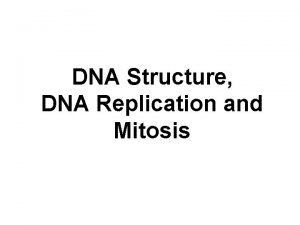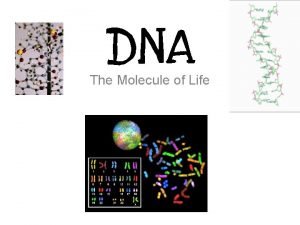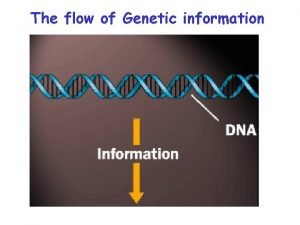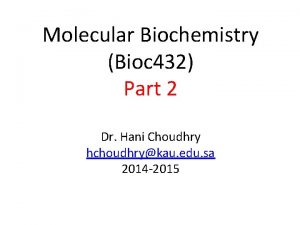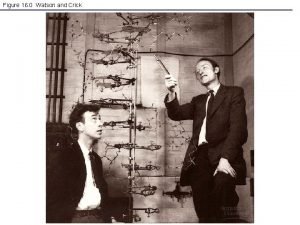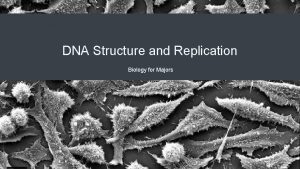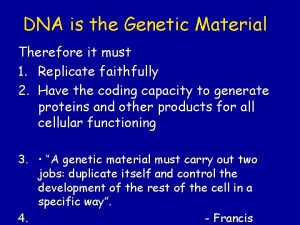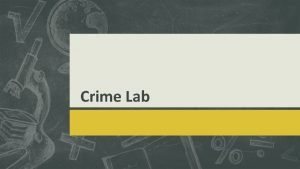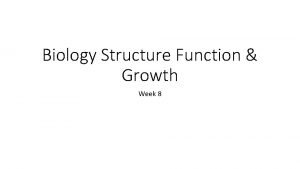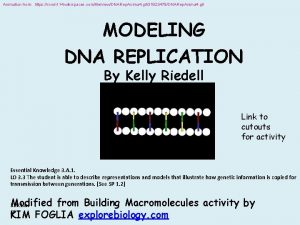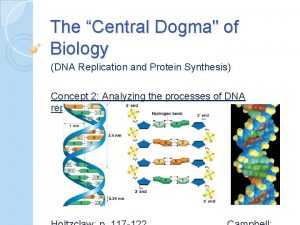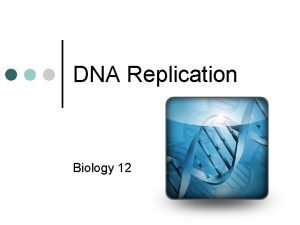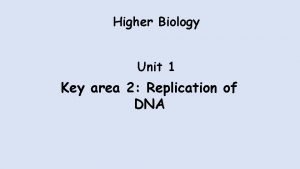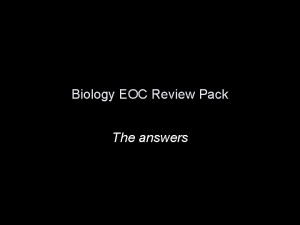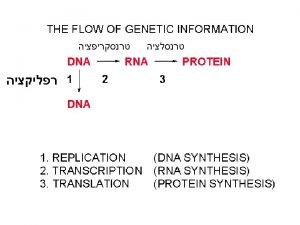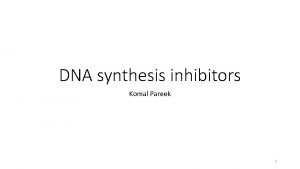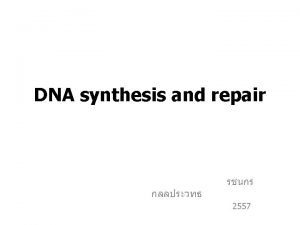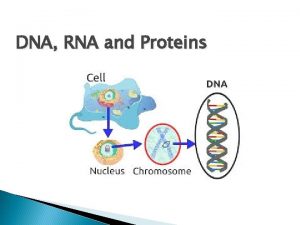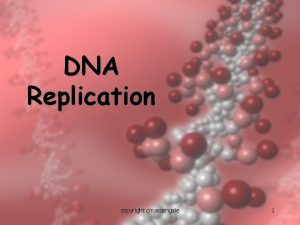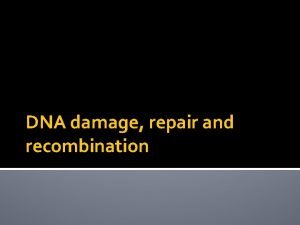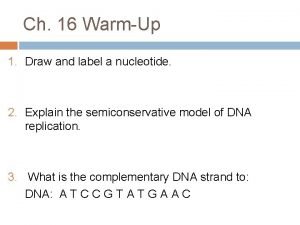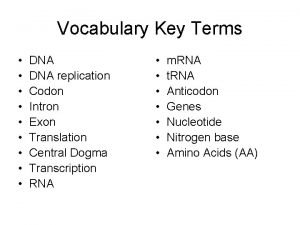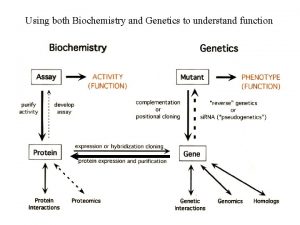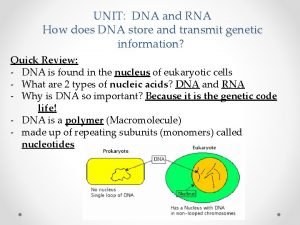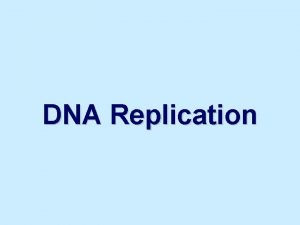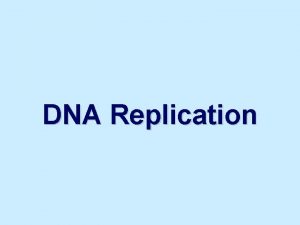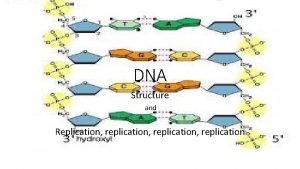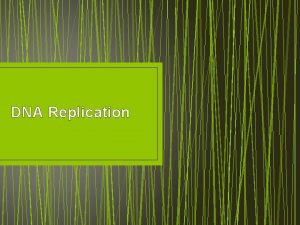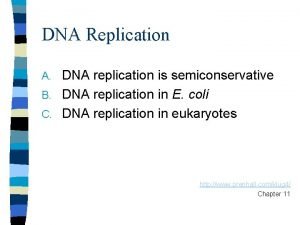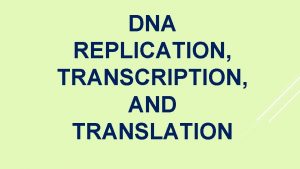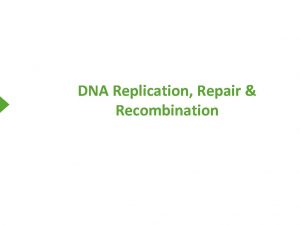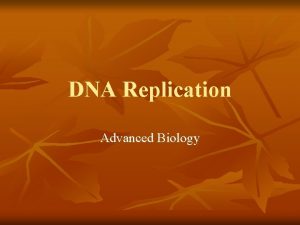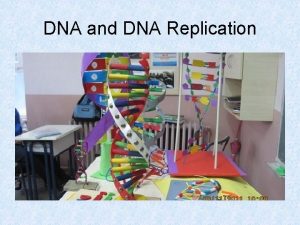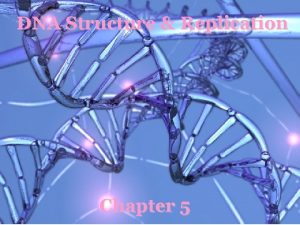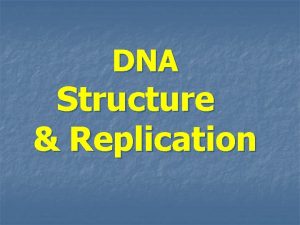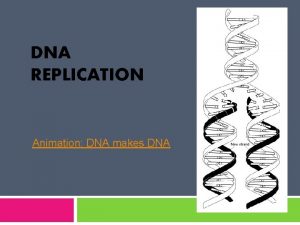DNA Structure Replication DNA Structure The discovery of


































- Slides: 34

DNA Structure & Replication

DNA Structure

The discovery of the structure Francis Crick and James Watson • The deoxyribonucleic acid (DNA) molecule is the genetic blueprint for each cell and ultimately the blueprint that determines every characteristic of a living organism. The DNA molecule was discovered in 1951 by Francis Crick, James Watson, and Maurice Wilkins using X-ray diffraction.

Photo Researchers, Inc. • "Francis Crick and James Watson, " Microsoft® Encarta® 98 Encyclopedia. © 1993 -1997 Microsoft Corporation. All rights reserved.

In 1953 Crick, left, and Watson, right, described the structure of the DNA molecule as a double helix, somewhat like a spiral staircase with many individual steps. In 1962 Crick, Watson, and Wilkins received the Nobel Prize for their pioneering work on the structure of the DNA molecule.

A little extra info • Although Maurice Wilkins from Cambridge is credited as a key player in the discovery, it was actually Rosalind Franklin, who was working in his lab, that used a technique called X-ray diffraction to her determine the structure of DNA – she got no credit for the discovery!

Watson/Crick Model of DNA • 1. 2 chains of nucleotides coiled around each other to form a double helix. • 2. The nitrogen bases of the 2 chains are joined together by weak hydrogen bonds. (easily broken)

Watson/Crick Model of DNA • 3. A specific purine base is paired with a specific pyrimidine base. Adenine with Thymine (A-T) Guanine with Cytosine (G-C) • 4. The sequence of base pairs along the DNA molecule determine the genetic code.

Structure

Structure • Looks like a twisted ladder • The “handrails” or backbone is made of the phosphate and 5 -C (pentose) sugar called deoxyribose • The “rungs” are made of the joined nitrogen bases • The nucleotides are joined together by covalent bonds into a single strand

Nitrogen Bases There are 4 different nitrogen bases • Adinine, Thymine, Guanine, Cytosine • As Chargaff’s rule indicates: • Adinine bonds with Thymine • Guanine bonds with Cytosine • Therefore there will always be equal amounts of A and T , G&C.


Purines • Nitrogen bases with a double ring structure • Adenine and Guanine

Pyrimidines • Nitrogen bases that have a single ring structure • Thymine and Cytosine (and Uracil of RNA)

Complementary Base Pairs • A two ring base will bind with a one ring base so that there always three rings that separate the backbone • Three hydrogen bonds attach cytosine to guanine • Two hydrogen bonds attach thymine to adenine.

Antiparallel • The two strands run opposite to each other Hydrogen bonds One end of the chain is 3’ (sugar end) the other end is 5’ (phosphate end)

Draw and label a simple diagram of the molecular structure of DNA Un-seeable Biology

What is a “genome”? • the genome is the entirety of an organism's hereditary information • The genome includes both the genes and the noncoding sequences of the DNA/RNA.

RNA • Not the same as DNA because: • The sugar component of RNA is ribose rather than deoxyribose • Uracil instead of Thymine • Remains single stranded, though it can fold back on itself to produce regions of complementary base pairs

THE CENTRAL DOGMA

Table 12. 01

Fig. 12. 08

DNA Replication Interphase of Mitosis/Meiosis • Semi conservative • Meaning one old strand combines with a new strand to produce two new double strands of DNA

Parent Molecule Separation of strands “Daughter” DNA molecules each consisting of one parent strand one new strand

Animation • http: //www. mcgrawhill. ca/school/applets/abbio/ch 18/dna_replicatio n. swf


DNA Replication • semi-conservative replication-new DNA molecule made of one parent and one newly replicated strand. • In general a DNA molecule ‘unzips’ down the middle of the paired bases, 2 individual strands are made that will become the ‘templates’ for new complete DNA stands

The Steps for DNA Replication (during S-phase of Interphase): 1. Initiation starts at a specific nucleotide sequence, a group of enzymes called DNA helicases breaks hydrogen bonds between bases to unzip the double helix 2. Proteins bind to keep strands apart


3) RNA primers attach to a spot on the original DNA stand 4) DNA polymerase III – starts at where the primer attached to the DNA and makes new strand in 5’ to 3’ direction (always)

5) DNA polymerase 1 – removes primers and replaces with nucleotide 6) DNA ligase – joins DNA fragments


• DNA Replication Remember—Replication 3’-5’

Build a DNA Replication DNA makes DNA Un-seeable Biology 2: 52
 Bioflix activity dna replication dna replication diagram
Bioflix activity dna replication dna replication diagram Replication
Replication Dna rna protein synthesis homework #2 dna replication
Dna rna protein synthesis homework #2 dna replication Haploid vs diploid
Haploid vs diploid Dna structure and replication packet answer key
Dna structure and replication packet answer key Nature of dna replication
Nature of dna replication Dna replication steps
Dna replication steps 3-5 exonuclease vs 5-3 exonuclease
3-5 exonuclease vs 5-3 exonuclease 5 enzymes responsible for dna replication
5 enzymes responsible for dna replication 3 models of dna replication
3 models of dna replication Major enzymes in dna replication
Major enzymes in dna replication Accgtat
Accgtat Dna jeopardy
Dna jeopardy Replication fork labeled
Replication fork labeled Missy baker
Missy baker What is this name
What is this name Nucleoside triphosphate in dna replication
Nucleoside triphosphate in dna replication Bioflix dna replication
Bioflix dna replication Protein synthesis restaurant analogy
Protein synthesis restaurant analogy Okazaki
Okazaki Dna replication transcription and translation
Dna replication transcription and translation Dna replication higher human biology
Dna replication higher human biology Why is dna replication considered semiconservative
Why is dna replication considered semiconservative Dna replication pearson
Dna replication pearson Direction of helicase
Direction of helicase Dna replication in bacteria occurs
Dna replication in bacteria occurs Dna replication
Dna replication Helicaee
Helicaee Dna replication comic strip
Dna replication comic strip Dna replication facts
Dna replication facts Accuracy of dna replication
Accuracy of dna replication Bioflix dna replication
Bioflix dna replication Dna replication
Dna replication Dna synthesis at replication fork
Dna synthesis at replication fork Dna replication phschool
Dna replication phschool





